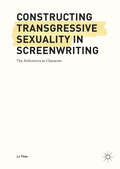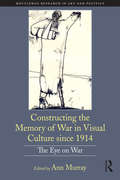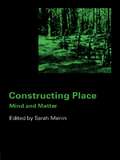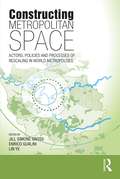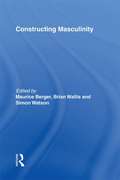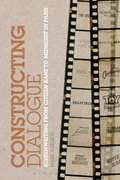- Table View
- List View
Construction: A Practical Guide to RIBA Plan of Work 2013 Stages 4, 5 and 6 (RIBA Stage Guide)
by Phil HoldenThis is the third in a must-have series of step-by-step guides to using the new RIBA Plan of Work 2013 on your project. Drawing together stages 4, 5 and 6 this book explains what needs to have been achieved for Technical Design to begin, how to achieve success in the construction phase as well as the importance of a comprehensive Handover Strategy.Providing a practical tool to running an efficient project each guide follows the same format leading you through the core tasks at each stage supported by tips, definitions, templates and useful techniques. Five theoretical scenarios are used throughout the guides to illustrate how the Plan of Work can be applied on various project types and sizes including an extension to a house, a new library and a large office building.These guides will provide unrivalled support for practices on all projects – large and small – and across all types of procurement.
Constructing Transgressive Sexuality in Screenwriting: The Feiticeiro/a as Character
by Lj TheoThis book approaches the construction of complex and transgressive ‘pervert’ characters in mainstream (not ‘art’), adult-oriented (not pornographic) cinema. It deconstructs an episteme on which to base the construction of characters in screenplays, in a way that acknowledges how semiotic elements of characterisation intersect. In addition, it provides an extended re-phrasing of the notion of ‘the pervert’ as Feiticiero/a: a newly-coined construct that might serve as an underpinning for complex, sexual filmic characters that are both entertaining and challenging to audiences. This re-phrasing speaks to both an existential/phenomenological conception of personhood and to the scholarly tradition of the ‘linguistic turn’ of continental philosophers such as Foucault and Lacan, who represent language not primarily as describing the world but as constructing it. The result is an original and interdisciplinary volume that is brought to coherence through a queer, post-humanist lens.
Constructing Transgressive Sexuality in Screenwriting: The Feiticeiro/a as Character
by Lj TheoThis book approaches the construction of complex and transgressive ‘pervert’ characters in mainstream (not ‘art’), adult-oriented (not pornographic) cinema. It deconstructs an episteme on which to base the construction of characters in screenplays, in a way that acknowledges how semiotic elements of characterisation intersect. In addition, it provides an extended re-phrasing of the notion of ‘the pervert’ as Feiticiero/a: a newly-coined construct that might serve as an underpinning for complex, sexual filmic characters that are both entertaining and challenging to audiences. This re-phrasing speaks to both an existential/phenomenological conception of personhood and to the scholarly tradition of the ‘linguistic turn’ of continental philosophers such as Foucault and Lacan, who represent language not primarily as describing the world but as constructing it. The result is an original and interdisciplinary volume that is brought to coherence through a queer, post-humanist lens.
Constructing the Viennese Modern Body: Art, Hysteria, and the Puppet (Studies in Art Historiography)
by Nathan J. TimpanoThis book takes a new, interdisciplinary approach to analyzing modern Viennese visual culture, one informed by Austro-German theater, contemporary medical treatises centered on hysteria, and an original examination of dramatic gestures in expressionist artworks. It centers on the following question: How and to what end was the human body discussed, portrayed, and utilized as an aesthetic metaphor in turn-of-the-century Vienna? By scrutinizing theatrically “hysterical” performances, avant-garde puppet plays, and images created by Oskar Kokoschka, Koloman Moser, Egon Schiele and others, Nathan J. Timpano discusses how Viennese artists favored the pathological or puppet-like body as their contribution to European modernism.
Constructing the Viennese Modern Body: Art, Hysteria, and the Puppet (Studies in Art Historiography)
by Nathan J. TimpanoThis book takes a new, interdisciplinary approach to analyzing modern Viennese visual culture, one informed by Austro-German theater, contemporary medical treatises centered on hysteria, and an original examination of dramatic gestures in expressionist artworks. It centers on the following question: How and to what end was the human body discussed, portrayed, and utilized as an aesthetic metaphor in turn-of-the-century Vienna? By scrutinizing theatrically “hysterical” performances, avant-garde puppet plays, and images created by Oskar Kokoschka, Koloman Moser, Egon Schiele and others, Nathan J. Timpano discusses how Viennese artists favored the pathological or puppet-like body as their contribution to European modernism.
Constructing the Persuasive Portfolio: The Only Primer You’ll Ever Need
by Margaret FletcherConstructing the Persuasive Portfolio helps you learn the art of designing a compelling and effective architectural portfolio. Margaret Fletcher categorizes the architectural portfolio design process into a step-by-step method that you can manage and understand. The full-color book includes 400 portfolio examples from 55 designers, along with more than 50 diagrams, and a set of 48 design actions that are marked throughout. You will learn how to:-Identify your readership-Collect, document, and catalog your work-Organize your portfolio-Visually structure your portfolio-Design your layout-Manage both printed and digital portfolio formats As your ultimate persuasive tool, your portfolio is the single most important design exercise of your academic and professional career. Constructing the Persuasive Portfolio shows you everything you need to know to create your portfolio and is the only portfolio design book you will ever need!
Constructing the Persuasive Portfolio: The Only Primer You’ll Ever Need
by Margaret FletcherConstructing the Persuasive Portfolio helps you learn the art of designing a compelling and effective architectural portfolio. Margaret Fletcher categorizes the architectural portfolio design process into a step-by-step method that you can manage and understand. The full-color book includes 400 portfolio examples from 55 designers, along with more than 50 diagrams, and a set of 48 design actions that are marked throughout. You will learn how to:-Identify your readership-Collect, document, and catalog your work-Organize your portfolio-Visually structure your portfolio-Design your layout-Manage both printed and digital portfolio formats As your ultimate persuasive tool, your portfolio is the single most important design exercise of your academic and professional career. Constructing the Persuasive Portfolio shows you everything you need to know to create your portfolio and is the only portfolio design book you will ever need!
Constructing the Memory of War in Visual Culture since 1914: The Eye on War (Routledge Research in Art and Politics)
by Ann MurrayThis collection provides a transnational, interdisciplinary perspective on artistic responses to war from 1914 to the present, analysing a broad selection of the rich, complex body of work which has emerged in response to conflicts since the Great War. Many of the creators examined here embody the human experience of war: first-hand witnesses who developed a unique visual language in direct response to their role as victim, soldier, refugee, resister, prisoner and embedded or official artist. Contributors address specific issues relating to propaganda, wartime femininity and masculinity, women as war artists, trauma, the role of art in soldiery, memory, art as resistance, identity and the memorialisation of war.
Constructing the Memory of War in Visual Culture since 1914: The Eye on War (Routledge Research in Art and Politics)
by Ann MurrayThis collection provides a transnational, interdisciplinary perspective on artistic responses to war from 1914 to the present, analysing a broad selection of the rich, complex body of work which has emerged in response to conflicts since the Great War. Many of the creators examined here embody the human experience of war: first-hand witnesses who developed a unique visual language in direct response to their role as victim, soldier, refugee, resister, prisoner and embedded or official artist. Contributors address specific issues relating to propaganda, wartime femininity and masculinity, women as war artists, trauma, the role of art in soldiery, memory, art as resistance, identity and the memorialisation of war.
Constructing the Colonized Land: Entwined Perspectives of East Asia around WWII
by Izumi KuroishiDespite the precipitous rise of East Asia as a center of architectural production since the Second World War, informed studies remain lacking. The lacuna is particularly conspicuous in terms of regional, cross-national studies, documenting the close ties and parallels between China, Taiwan, Japan and Korea during this period. Examining colonized cities in East Asia, this book brings together a range of different perspectives across both space and time. European, Chinese, Taiwanese, Korean and Japanese discourses are examined, with a range of complementary and conflicting views on the design of urban and architectural forms; the political, institutional, religious and economical contexts of urban planning; the role played by various media; and the influence of various geographical, social and anthropological research methods. The diversity and plurality of these perspectives in this book provides an entwined architectural, urban and social history of East Asia, which offers insights into the cultural systems and the historical and spatial meanings of these colonized cities. It concludes that the difficulties in the historical study of East Asia's colonial cities do not so much indicate cultural difference as the potentiality for multiple readings of the past toward the future.
Constructing the Colonized Land: Entwined Perspectives of East Asia around WWII (Design And The Built Environment Ser.)
by Izumi KuroishiDespite the precipitous rise of East Asia as a center of architectural production since the Second World War, informed studies remain lacking. The lacuna is particularly conspicuous in terms of regional, cross-national studies, documenting the close ties and parallels between China, Taiwan, Japan and Korea during this period. Examining colonized cities in East Asia, this book brings together a range of different perspectives across both space and time. European, Chinese, Taiwanese, Korean and Japanese discourses are examined, with a range of complementary and conflicting views on the design of urban and architectural forms; the political, institutional, religious and economical contexts of urban planning; the role played by various media; and the influence of various geographical, social and anthropological research methods. The diversity and plurality of these perspectives in this book provides an entwined architectural, urban and social history of East Asia, which offers insights into the cultural systems and the historical and spatial meanings of these colonized cities. It concludes that the difficulties in the historical study of East Asia's colonial cities do not so much indicate cultural difference as the potentiality for multiple readings of the past toward the future.
Constructing the Architect: An Introduction to Design, Research, Planning, and Education
by Leonard R. BachmanUnlike books that concentrate on the monuments and other artefacts that architects produce, Constructing the Architect focuses on architecture as a disciplinary and professional process, an institution of society, and a career of learning and mastery. In doing so, it offers a lens into the architecture of architecture. Mapping architecture as a coherent whole, Leonard Bachman shows that the field must be understood as four mutually reinforcing modes of inquiry: design, research, strategy, and education. Within this framework, he explains how institutions and actors hold differing perspectives on the critical discourse that advances architecture and identifies the various tensions and leverage points for change within the discipline. Featuring over 100 illustrations to support understanding of this highly visual subject, this is an essential introduction for any student seeking to understand what it means to be an architect and to enter the professional discourse.
Constructing the Architect: An Introduction to Design, Research, Planning, and Education
by Leonard R. BachmanUnlike books that concentrate on the monuments and other artefacts that architects produce, Constructing the Architect focuses on architecture as a disciplinary and professional process, an institution of society, and a career of learning and mastery. In doing so, it offers a lens into the architecture of architecture. Mapping architecture as a coherent whole, Leonard Bachman shows that the field must be understood as four mutually reinforcing modes of inquiry: design, research, strategy, and education. Within this framework, he explains how institutions and actors hold differing perspectives on the critical discourse that advances architecture and identifies the various tensions and leverage points for change within the discipline. Featuring over 100 illustrations to support understanding of this highly visual subject, this is an essential introduction for any student seeking to understand what it means to be an architect and to enter the professional discourse.
Constructing Race on the Borders of Europe: Ethnography, Anthropology, and Visual Culture, 1850-1930
by Marsha Morton and Barbara LarsonConstructing Race on the Borders of Europe investigates the visual imagery (in painting, photography, prints, film, and design) of race construction primarily in Scandinavia and the empires of Austro-Hungary, Germany, and Russia at a time when the disciplines of ethnography and anthropology were expanding and publications on race were debating competing theories of biological, geographic, linguistic, and cultural determinants. These regions, while on the periphery of continental Europe, largely marginalized in the scholarship of nineteenth-century art history, and ignored by Edward Said (Orientalism 1978), have been central locations for theorizing white identity and for containing diverse ethnic populations that have generated substantive ethnographic study and regional conflicts since the eighteenth century. This anthology explores art that engaged with ethnography and anthropology to shape visual representations of subordinate ethnic populations and material cultures, both indigenous (Roma, Sámi, Inuit, and Celts) and migrant or colonial (Muslims and Blacks), chiefly between 1850 and 1930, but extending into the early twenty-first century. The essays in this book contribute to postcolonial research by documenting colonial-style treatment of minority groups and by seeking to qualify binary systems through explorations of anomalies, complexities, and contradictions that emerge when seen from the perspective of the fine and applied arts. This book presents a range of different artistic voices that responded to ethnographic and anthropological information by producing images or objects that adopted, altered, or critiqued that information. The authors seek to uncover instances of connections and variability, to establish the fabricated nature of ethnic identity, and to challenge the certainties of racial categorization.
Constructing Race on the Borders of Europe: Ethnography, Anthropology, and Visual Culture, 1850-1930
Constructing Race on the Borders of Europe investigates the visual imagery (in painting, photography, prints, film, and design) of race construction primarily in Scandinavia and the empires of Austro-Hungary, Germany, and Russia at a time when the disciplines of ethnography and anthropology were expanding and publications on race were debating competing theories of biological, geographic, linguistic, and cultural determinants. These regions, while on the periphery of continental Europe, largely marginalized in the scholarship of nineteenth-century art history, and ignored by Edward Said (Orientalism 1978), have been central locations for theorizing white identity and for containing diverse ethnic populations that have generated substantive ethnographic study and regional conflicts since the eighteenth century. This anthology explores art that engaged with ethnography and anthropology to shape visual representations of subordinate ethnic populations and material cultures, both indigenous (Roma, Sámi, Inuit, and Celts) and migrant or colonial (Muslims and Blacks), chiefly between 1850 and 1930, but extending into the early twenty-first century. The essays in this book contribute to postcolonial research by documenting colonial-style treatment of minority groups and by seeking to qualify binary systems through explorations of anomalies, complexities, and contradictions that emerge when seen from the perspective of the fine and applied arts. This book presents a range of different artistic voices that responded to ethnographic and anthropological information by producing images or objects that adopted, altered, or critiqued that information. The authors seek to uncover instances of connections and variability, to establish the fabricated nature of ethnic identity, and to challenge the certainties of racial categorization.
Constructing Place: Mind and the Matter of Place-Making
by Sarah MeninThis book is a cutting edge study examining the attitudes to both nature and the built environment of the designer, the client and the society in which an intervention (be it architecture, landscape design or a piece of art) is made. The legacy of the Modernist view of nature and the environment is also addressed, and the degree to which such ideas continue to impinge on contemporary interventions is assessed.
Constructing Place: Mind and the Matter of Place-Making
by Sarah MeninThis book is a cutting edge study examining the attitudes to both nature and the built environment of the designer, the client and the society in which an intervention (be it architecture, landscape design or a piece of art) is made. The legacy of the Modernist view of nature and the environment is also addressed, and the degree to which such ideas continue to impinge on contemporary interventions is assessed.
Constructing Metropolitan Space: Actors, Policies and Processes of Rescaling in World Metropolises
by Jill Simone Gross Enrico Gualini Lin YeThere is little question today that processes of globalization affect national and local economies, governance processes, and conditions for economic competitiveness in the major urban regions of the world. In most liberal-democratic countries, these processes are occurring according to a rationale which attempts to combine strategies of state-supported development with increasing local-regional governmental decentralization and autonomy. Against this background, the issue of metropolitan development is being redefined worldwide, along with its institutional frameworks, modes of governance, policy instruments, and spatial planning strategies. The overarching assumption of this volume is that ‘metropolitan space’, far from being consolidated as a policy object, is currently being redefined and in some instances ‘constructed’ and contested as a scale, through a variety of policy practices related to spatial-economic development objectives. Through case studies drawn from across four continents, the authors reveal a range of interesting cross-national commonalities concerning the power that state actors, situated at various spatial scales, exert as agents in these processes. This volume interrogates key research issues raised by these developments, and is intended as a contribution to the establishment of a globally comparative analysis of the construction of metropolitan spaces and scales under conditions of globalization and neoliberalization.
Constructing Metropolitan Space: Actors, Policies and Processes of Rescaling in World Metropolises
by Jill Simone Gross Enrico Gualini Lin YeThere is little question today that processes of globalization affect national and local economies, governance processes, and conditions for economic competitiveness in the major urban regions of the world. In most liberal-democratic countries, these processes are occurring according to a rationale which attempts to combine strategies of state-supported development with increasing local-regional governmental decentralization and autonomy. Against this background, the issue of metropolitan development is being redefined worldwide, along with its institutional frameworks, modes of governance, policy instruments, and spatial planning strategies. The overarching assumption of this volume is that ‘metropolitan space’, far from being consolidated as a policy object, is currently being redefined and in some instances ‘constructed’ and contested as a scale, through a variety of policy practices related to spatial-economic development objectives. Through case studies drawn from across four continents, the authors reveal a range of interesting cross-national commonalities concerning the power that state actors, situated at various spatial scales, exert as agents in these processes. This volume interrogates key research issues raised by these developments, and is intended as a contribution to the establishment of a globally comparative analysis of the construction of metropolitan spaces and scales under conditions of globalization and neoliberalization.
Constructing Masculinity
by Maurice Berger Brian Wallis Simon WatsonThis anthology takes us beyond the status of masculinity itself, questioning society's and the media's normative concepts of the masculine, and considering the extent to which men and women can transcend these stereotypes and prescriptions.
Constructing Masculinity
by Maurice Berger Brian Wallis Simon WatsonThis anthology takes us beyond the status of masculinity itself, questioning society's and the media's normative concepts of the masculine, and considering the extent to which men and women can transcend these stereotypes and prescriptions.
Constructing Dialogue: Screenwriting from Citizen Kane to Midnight in Paris
by Mark AxelrodUnlike most screenwriting guides that generally analyze several aspects of screenwriting, Constructing Dialogue is devoted to a more analytical treatment of certain individual scenes and how those scenes were constructed to be the most highly dramatic vis á vis their dialogue. In the art of screenwriting, one cannot separate how the scene is constructed from how the dialogue is written. They are completely interwoven. Each chapter deals with how a particular screenwriter approached dialogue relative to that particular scene's construction. From Citizen Kane to The Fisher King the storylines have changed, but the techniques used to construct scene and dialogue have fundamentally remained the same. The author maintains that there are four optimum requirements that each scene needs in order to be successful: maintaining scenic integrity; advancing the storyline, developing character, and eliciting conflict and engaging emotionally. Comparing the original script and viewing the final movie, the student is able to see what exactly was being accomplished to make both the scene and the dialogue work effectively.
Constructing Dialogue: Screenwriting from Citizen Kane to Midnight in Paris
by Mark AxelrodUnlike most screenwriting guides that generally analyze several aspects of screenwriting, Constructing Dialogue is devoted to a more analytical treatment of certain individual scenes and how those scenes were constructed to be the most highly dramatic vis á vis their dialogue. In the art of screenwriting, one cannot separate how the scene is constructed from how the dialogue is written. They are completely interwoven. Each chapter deals with how a particular screenwriter approached dialogue relative to that particular scene's construction. From Citizen Kane to The Fisher King the storylines have changed, but the techniques used to construct scene and dialogue have fundamentally remained the same. The author maintains that there are four optimum requirements that each scene needs in order to be successful: maintaining scenic integrity; advancing the storyline, developing character, and eliciting conflict and engaging emotionally. Comparing the original script and viewing the final movie, the student is able to see what exactly was being accomplished to make both the scene and the dialogue work effectively.
Constructing Crime: Discourse and Cultural Representations of Crime and 'Deviance'
by Christiana GregoriouCrime and criminals are a pervasive theme in all areas of our culture, including media, journalism, film and literature. This book explores how crime is constructed and culturally represented through a range of areas including Spanish, English Language and Literature, Music, Criminology, Gender, Law, Cultural and Criminal Justice Studies.
Constructing Building Enclosures: Architectural History, Technology and Poetics in the Postwar Era
by Clifton FordhamConstructing Building Enclosures investigates and interrogates tensions that arose between the disciplines of architecture and engineering as they wrestled with technology and building cultures that evolved to deliver structures in the modern era. At the center of this history are inventive architects, engineers and projects that did not settle for conventional solutions, technologies and methods. Comprised of thirteen original essays by interdisciplinary scholars, this collection offers a critical look at the development and the purpose of building technology within a design framework. Through two distinct sections, the contributions first challenge notions of the boundaries between architecture, engineering and construction. The authors then investigate twentieth-century building projects, exploring technological and aesthetic boundaries of postwar modernism and uncovering lessons relevant to enclosure design that are typically overlooked. Projects include Louis Kahn’s Weiss House, Minoru Yamasaki’s Science Center, Sigurd Lewerentz’s Chapel of Hope and more. An important read for students, educators and researchers within architectural history, construction history, building technology and design, this volume sets out to disrupt common assumptions of how we understand this history.

